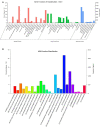Identification of Odorant-Binding and Chemosensory Protein Genes in Mythimna separata Adult Brains Using Transcriptome Analyses
- PMID: 35295575
- PMCID: PMC8918689
- DOI: 10.3389/fphys.2022.839559
Identification of Odorant-Binding and Chemosensory Protein Genes in Mythimna separata Adult Brains Using Transcriptome Analyses
Abstract
Large numbers of chemosensory genes have been identified in the peripheral sensory organs of the pest Mythimna separata (Walker) to increase our understanding of chemoreception-related molecular mechanisms and to identify molecular targets for pest control. Chemosensory-related genes are expressed in various tissues, including non-sensory organs, and they play diverse roles. To better understand the functions of chemosensory-related genes in non-sensory organs, transcriptomic analyses of M. separata brains were performed. In total, 29 odorant-binding proteins (OBPs) and 16 chemosensory proteins (CSPs) putative genes were identified in the transcriptomic data set. The further examination of sex- and tissue-specific expression using RT-PCR suggested that eight OBPs (OBP5, -7, -11, -13, -16, -18, -21, and -24) and eight CSPs (CSP2-4, -8, CSP10-12, and -15) genes were expressed in the brain. Furthermore, bands representing most OBPs and CSPs could be detected in antennae, except for a few that underwent sex-biased expression in abdomens, legs, or wings. An RT-qPCR analysis of the expression profiles of six OBPs (OBP3-5, -9, -10, and -16) and two CSPs (CSP3 and CSP4) in different tissues and sexes indicated that OBP16 was highly expressed in male brain, and CSP3 and CSP4 were female-biased and highly expressed in brain. The expression levels of OBP5 and OBP10 in brain were not significantly different between the sexes. The findings expand our current understanding of the expression patterns of OBPs and CSPs in M. separata sensory and non-sensory tissues. These results provide valuable reference data for exploring novel functions of OBPs and CSPs in M. separata and may help in developing effective biological control strategies for managing this pest by exploring novel molecular targets.
Keywords: Mythimna separata; brain transcriptome; chemosensory genes; chemosensory protein; non-sensory organ; odorant binding protein.
Copyright © 2022 Chen, Du, Gao, Sun, Chen, Xie, An and Zhao.
Conflict of interest statement
The authors declare that the research was conducted in the absence of any commercial or financial relationships that could be construed as a potential conflict of interest.
Figures








Similar articles
-
Integrative transcriptomic and genomic analysis of odorant binding proteins and chemosensory proteins in aphids.Insect Mol Biol. 2019 Feb;28(1):1-22. doi: 10.1111/imb.12513. Epub 2018 Oct 5. Insect Mol Biol. 2019. PMID: 29888835 Free PMC article.
-
Identification of candidate chemosensory genes in Mythimna separata by transcriptomic analysis.BMC Genomics. 2018 Jul 4;19(1):518. doi: 10.1186/s12864-018-4898-0. BMC Genomics. 2018. PMID: 29973137 Free PMC article.
-
Candidate genes coding for odorant binding proteins and chemosensory proteins identified from dissected antennae and mouthparts of the southern green stink bug Nezara viridula.Comp Biochem Physiol Part D Genomics Proteomics. 2019 Sep;31:100594. doi: 10.1016/j.cbd.2019.100594. Epub 2019 May 11. Comp Biochem Physiol Part D Genomics Proteomics. 2019. PMID: 31170686
-
Sex- and stage-dependent expression patterns of odorant-binding and chemosensory protein genes in Spodoptera exempta.PeerJ. 2021 Sep 13;9:e12132. doi: 10.7717/peerj.12132. eCollection 2021. PeerJ. 2021. PMID: 34603852 Free PMC article.
-
Beyond chemoreception: diverse tasks of soluble olfactory proteins in insects.Biol Rev Camb Philos Soc. 2018 Feb;93(1):184-200. doi: 10.1111/brv.12339. Epub 2017 May 7. Biol Rev Camb Philos Soc. 2018. PMID: 28480618 Review.
Cited by
-
Identification and Pharmacological Characterization of Two Serotonin Type 7 Receptor Isoforms from Mythimna separata.Int J Mol Sci. 2022 Dec 30;24(1):655. doi: 10.3390/ijms24010655. Int J Mol Sci. 2022. PMID: 36614100 Free PMC article.
-
Global characterization of gene expression in the brain of starved immature Rhodnius prolixus.PLoS One. 2023 Mar 3;18(3):e0282490. doi: 10.1371/journal.pone.0282490. eCollection 2023. PLoS One. 2023. PMID: 36867641 Free PMC article.
References
-
- Chang H., Dong A., Zhang J., Dong S., Liu Y., Wang G. (2017). Candidate odorant binding proteins and chemosensory proteins in the larval chemosensory tissues of two closely related noctuidae moths, Helicoverpa armigera and H. assulta. PLoS One 12:e0179243. 10.1371/journal.pone.0179243 - DOI - PMC - PubMed
LinkOut - more resources
Full Text Sources

